 |
| The Schlieren experiment, as featured in I See A Darkness |
When did photography become cinema? How has the evolution of cinema shaped what we see and how we interpret it? How has science contributed to this, and what alternative technologies have come and gone along the way? These fascinating questions and more are addressed in Katherine Waugh and Fergus Daly's rich cinematic essay I See A Darkness, screening as part of Docs Ireland 2024. Just before the festival, Katherine agreed to answer some questions about the film and the many more questions it will leave viewers wondering about.
Jennie Kermode: There are multiple strands in this documentary and the connections might not be obvious to viewers before they've watched it. how did they all come together for you?
Kathering Waugh: Fergus and I have often described our practice as being about shadow archives in culture; those areas that are hidden or sublimated in some way as they don’t easily fit dominant cultural or political narratives. With this film, as with other work we have done, it wasn’t so much a case of forcing connections between subjects as revealing existing connections. We often thought of it as being similar to the process of photographic development itself— the matter was there and we just drew attention to it within a specific framework. The problem of how to reveal such connections in a non-dogmatic, more artistic way that allowed for viewers to be drawn into a conceptual mapping of a history of ideas relating to science, cinematography and the animal, was the challenge for us.
We do think that it’s important that viewers are challenged watching such films and are prepared to trust the filmmakers and take the risk of going with them in how they unfold certain ideas. We personally love that feeling when we watch film essays that we find thought-provoking. Rather than it feeling like a threat, or trigger a feeling of boredom when you don’t experience a known visual or narrative pleasure, we feel that creating at times awkward disjunctions is a positive process. Last night I fell upon a film interview with Paul Schrader talking about Bresson’s Pickpocket, and how Bresson intentionally creates disjunctive moments to create a certain tension and even anxiety in the viewer, as a kind of cliché-busting technique, but done in order to create other more poetic and transcendent moments later in the film. In a way we explicitly tried to create tensions between ostensibly conventional documentary-style footage about the history of early cinematic devices or nuclear testing, and filmed interviews, set against other far more abstract footage, to try to encourage viewers to question how any form of knowledge is visualised and normalised or institutionalised.
It is also a way of challenging the conventional narrative revelatory structure of documentaries on such subject matter, or even, say, as with films such as those of Adam Curtis, where the joining of all the dots gives the viewer a payoff of sorts. We were seeking a more elusive elegiac tone that doesn’t offer a payoff, apart from hoping it makes people think more about subjects they might presume are not interconnected, when they are, and in more fascinating ways than one would imagine.
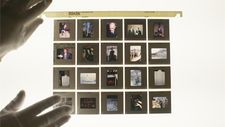 |
| Images at MIT, as seen in I See A Darkness |
With our film, we knew for example that the history of the invention of cinematic devices was deeply embedded with the history of science, but also with the military-industrial complex. We were aware of this from our interest in the work of many cultural theorists and philosophers who wrote about these areas – from Foucault to Paul Virilio, whose book War And Cinema exposed the military drive that spurred the invention of new cameras for reconnaissance, up to the more recent work of thinkers such as Jimena Canales and Jonathan Crary.
We felt that the rapid acceleration in digital visual technologies was for sure being written about in political ways, but we weren’t seeing more interesting mappings of some of the problems created in this cultural area by the naturalisation of this acceleration, being presented in a film essay format.
More often than not certain subjects tend to be kept very separate along traditional divisions around art and science, and the fascinating historical framework we wanted to include was one we just weren’t seeing in film – looking again at chrono-photography and the work of Irish-born Lucien Bull and seeing if a re-conceptualisation of his achievements in developing high speed photography of almost incomprehensible speeds could also encompass the nuclear test photography and atom bomb research of Harold Edgerton at MIT and the underwater filming of Jacques Cousteau.
The animal strand presented itself through our own personal interest around its relevance in philosophical and political terms, but also through the writing of some of the participants in our film such as Akira Mizuta Lippit who has written about the atomic and cinema, but also animality and cinema. It emerged as a theme additionally through the nuclear test videos of animal experiments we found whilst researching in film archives.
The use of insects and animals was of course there, as we show, at the foundation of cinema in the filming of animal movement in chrono-photography, but became a lot darker in later filmed experiments on animals.
JK: It's such a vast subject that it would be easy to be pulled in multiple directions and lose all sense of structure. How did you decide which elements were important, and what were your priorities in weaving them together?
KW: I think what we tend to find is that the dominant structures used in most of mainstream cinema and documentaries work by repeating a lot that is already known, or reassuring the viewers that the very conventional structures used are there as a kind of safety net; as if it is the sole aim of a film is to make sure that a viewer leaves the cinema feeling secure and with issues resolved, even if being provoked in an obvious way is the resolution itself.
In essence there are three threads in our film, and all are deeply connected historically and politically, but we wanted to open the viewer up to affective states that show how there are broader and more complex ideas that radiate from these three subjects that deserve pondering as well. The issue of the very materiality of the world itself and what vision is, and what light and shadow are, were subjects we wanted to allude to but using ideas from literature and philosophy, as well as just using images that carried their own weight and affective regime.
We did in fact leave out a lot when editing, and we were editing during Covid lockdowns and rethinking our own relationship with the visual and the animal as we were living in a small cottage on the Ox mountains walking miles every day staring at mountains and sheep and the sea, and also by chance we ended up fostering rescue goats we became besotted with.
Spending a lot of time in that environment inevitably bled into our editing and the film’s structure. At that time as well the cultural position of science as a discipline became far more dominant and acquired an urgency, and we saw this extreme polarisation in intellectual terms develop around how one was allowed to critique science in its industrial capitalist mode of functioning.
As we are interested in the philosophy of science and looking at it as a form of knowledge acquisition which like many other forms is in no way neutral or pure, we felt drawn to looking more closely at how science, like cinema, has different histories, shadow histories, an area that the philosopher of science and technology Jimena Canales (who is in our film) writes about so well.
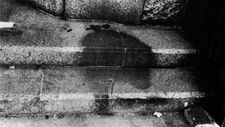 |
| A Hiroshima shadow, as seen in I See A Darkness |
There is always a point in making a film where the subjects kind of weave themselves together, in that after looking at all the footage again and again, and reading and researching and thinking as much as you can about it, and questioning all your previous ideas, this process seems to happen almost organically as you edit, and connections begin to seem necessary and cannot be ignored or cut out.
Again, maybe it’s another version of what Bresson asked of his non-actors – to walk upstairs so many times that the act of doing it becomes de-naturalised and something new emerges. We went through a version of that with all our material. Ultimately, we wanted to encourage people to question a lot of taken-for-granted cultural ideas about cinema and science and the human, and also to try to awaken an awareness of the cost the animal world has had to pay for human experimentation.
JK: The digital age is increasingly distancing young people from an understanding of how images are captured on film and how those technologies were first developed. What are your feelings about the importance of preserving this history, and helping people to relate to the sense of wonder involved?
KW: Firstly,I would say that even outside of the history of image-capture, the teaching of history itself is absolutely crucial and should be a subject taught to all students up to leaving school, not necessarily as an exam subject (except for those who want to pursue it academically) but as a profoundly important background to understanding the present.
I once taught a course on the history of ideas in contemporary art and my focus was on trying to make it obvious to students that no subject or discipline exists in its own atomised world: you couldn’t possibly be expected to understand movements in contemporary art for example without also knowing about what was happening in literature, film, music, philosophy and science at that time. I would try to show how so many ideas being experimented with by composers say were drawing on quantum physics and vice versa as it was never a one-way process, and great writers of any period are important to be aware of when looking at the art of their time, as art doesn’t exist in a realm removed from language.
That used to be a given but in the last 30 years the increasing segregation of areas of knowledge into ‘professional’ streams has been disastrous and dangerous, as it reduces the ability to think critically about what are very real connections between different phenomena socially, culturally and politically.
More directly, in terms of the question you ask, in relation to how important it is for young people to gain some understanding of the history of digital technologies – well outside of the importance of providing a history and framework for the more urgent political ramifications of deepfake images and algorithmically targeted propaganda, what is most important is dispelling the myth that what we have available to us today is the result of some logic of increasing perfection where better and better tools were invented to make life easier and more pleasurable for us lucky humans. What you learn from looking closely at the history of technology, and certainly the history of image-capture, is that this logic is very far from any reality.
What we use and what has been made available to us cannot be separated from the history of capitalism and the drive to profit from inventions. Needs are endlessly constructed rather than fulfilled, as in it isn’t need that drives invention, but inventions frequently drive need.
Becoming aware of this history makes one aware as well that what is seen as a more sophisticated visual tool has in fact had to sacrifice a lot to gain a certain functionality, that the end products, including visual ones that shape our world so much, have very specific agendas built into them and are not mere neutral tools. Jonathan Crary’s book Scorched Earth: Beyond The Digital Age To A Post-Capitalist World is a brilliant take down of that rationality.
What is always fascinating I find is to see how many supposedly ‘failed’ inventions and ideas from technology, including cameras, but also ideas in social and political experiments, didn’t fail because they were inadequate, but simply because they were rejected for other highly contingent and specific reasons at the time.
We spent time researching in the Conservatoire des Techniques de la Cinémathèque Française in Paris, which houses an archive of many instruments and pieces of equipment from early cinema, and what was extraordinary was seeing all these very beautiful cameras and forms of sound equipment that were sidelined not because they were useless or technically problematic, but because they didn’t align with the intentions and aesthetic of a new industrial cinema. Certainly, we felt wonder seeing them.
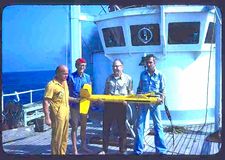 |
| Harold E Edgerton and Jacques Cousteau on the USS Monitor sonar survey in 1979 |
When we had our film screen as part of a larger exhibition that I curated with Tanya Kiang of Photo Museum Ireland in Dublin, Tanya organised a number of workshops around the camera obscura and chrono-photography for children so that they could experience the magic of image-capture in a very material form. This was anything but an exercise in nostalgia, rather it was the creation of a very important cultural, philosophical and political framework that we felt was crucial in trying to de-naturalise the visual grooming processes most children now are subjected to with smartphone culture.
JK: There are some shocking scenes of animal cruelty in the film - all historically relevant, of course, but they will be upsetting for some viewers. What factors were involved in your decision to show them in full?
KW: I’m glad you asked this question as it’s very important for us that those images are not seen as gratuitous images of cruelty included for sensational purposes. I can’t tell you how long and hard we thought about including them, and we only put them at the very end of the film, after making huge efforts to create a very careful mapping of ideas and a context within which to frame them. In this sense we did everything possible not to have those images function as mere attention-grabbers or to have a shock function.
Our prologue shows very different images of animal life and tried to give some sense of agency to the animals filmed and to complicate the act of looking at them. We were very intent on creating a strong critical and ontological framework in advance of showing the clips you mention, including having Akira Lippit read from his book Electric Animal (about the animal’s relation with, and impact on, philosophy, literature, science and cinema).
Lippit said in an interview about Electric Animal “The animal is perhaps the place where life as such has been most excluded in the history of human cultures. And as such it is the place, perhaps, where this rethinking has to begin.” For him the question of the animal is “critically linked to the question of cinema, and the arrival of cinema, and the force of cinema throughout the 20th century.”
In our practice’s focus on ‘shadow archives’ we wanted to draw attention to very real links that exist between the military and marine nature filming, and reveal for example the strong connections between the work of figures such as Jacques Cousteau, himself an ex-naval officer, and the research being done by Edgerton for the Atomic Energy Commission. It could be said that in ethical terms blowing up areas of marine life to get the best shots didn’t trouble Cousteau because of this background, and the instinct to use all means available to pursue scientific ‘research’ was a recurring problem.
So, our placing that footage you mention at the end of our film — which consisted of clips from the US Atomic Energy Commission’s own archives, was a way of returning to the question of the animal and cinema, but also felt absolutely necessary in terms of showing the way science sought to use animals for experiments and film them. The filming as a supposed act of knowledge acquisition but really as a form of justifying and rendering epistemological value to such image-capturing, as opposed to say scientific note-taking, is of immense importance.
The images and clips used are about the eye of the institution that made those films – the atomic energy commission-and what it says about them, as much as showing the casual and brutal cruelty depicted in the name of science. We are showing in real terms how a constructed rationality of supposed objective visual information-gathering works and how the codes involved in such filming operate.
So, there is that important political and philosophical framework there, but of course we personally were horrified and enraged by the footage we saw, mostly because this was footage that has been hidden for so long, so it had that affective capacity of hitting us harder as it hadn’t been exposed enough in a cultural sense to allow for a process of de-sensitisation. I personally have been deeply committed to animal welfare and challenging the abuse and exploitation of animals since I was a teenager, but that time we both spent caring for rescued animals during the making of our film, did impact on us profoundly. It meant that seeing images of goats being tied up on ships about to be blasted with nuclear bombs, just to see how their skin burned from the radiation, was very hard to watch.
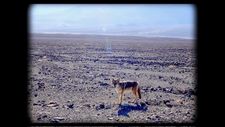 |
| A coyote in Death Valley |
I’m painfully aware of the problem of over-exposure to shocking images and, as I have already said about our avoidance of other images of war in our film, such as footage of burnt bodies in Hiroshima or Nagasaki, it comes down to how much a set of images has been instrumentalised or manipulated for specific reasons. We felt that the footage you mention hadn’t been and, to be honest, though I don’t agree with ‘upsetting’ people just as a form of emotional pornography, I do think people do still need to see evidence of brutality they don’t know about or haven’t a pre-existing visual imaginary for.
Images of the horrors of war in terms of how people brutalised by it are shown, are so common and saturate our media so much that they do often function in a de-sensitising way. But we felt that these images eluded that process as they haven’t been seen by the general public at all.
Our aim was to respond to the call that Bailly makes in his book The Animal Side (quoted at the start of our film) which recognises that “the world in which we live is gazed upon by other beings, that the visible is shared among creatures, and that a politics should be invented on this basis, if it is not too late.”
JK: Do you feel that the photographic images of people created by the atomic bombs in Japan can have a more visceral impact on our understanding of what those bombs did than watching footage of ruined buildings and survivors, or hearing stories about what happened? Do they have a relationship to the way that we try to preserve our own lost loved ones through photos and film?
KW: Again this is a really good question and one that has troubled so many philosophers and theorists of the image — the problem of the politics of war photography and the complicities involved, but also framing rationalities.
A lot of more recent writing post 9/11 and the Gulf War from philosophers such as Judith Butler has sought to focus on more contemporary debates around photographic sensationalism and de-humanisation (for example the photographs of torture taken at Abu Ghraib prison) although these issues of course were present from the Vietnam war as well.
The subject of the atomic shadow photographs we wanted to address has a different ontological register, in that it directly confronts the materiality of photography itself, and escapes more conventional interpretative analysis. It tends to trigger total incomprehension in many people who aren’t familiar with that phenomenon – that the atomic bomb itself acted like a giant camera and left these shadows of people and objects that were totally obliterated by the force of the bombs.
Akira Lippitt writes in his book Atomic Light (Shadow Optics) that the atomic bombings “introduced a visuality of the invisible, a mode of avisuality. They heralded a form of unimaginable devastation, in contrast to more recent forms of warfare, which, for distant televisual observers, produce only images.” He suggests that the atom bombs — as weapons of light (following Paul Virilio) — introduce new modes of visuality and ultimately a crisis of visuality.
Jean-Christophe Bailly, whose work we quote in our film on a few occasions, writes in his beautiful book The Instant And Its Shadow: A Story Of Photography, that the atomic shadow photographs become “a kind of tragic condensation of a power attached to photography. A shadow imprinted directly on the skin of the world, on a wall that has become a sensitive plate…” and adds that “the caesura in every photographic image contains the program for the disappearance of what it suspends and salvages.”
The shadow photos of Hiroshima and Nagasaki act like photogenic drawings, erasing their subject at the very second of their capture, and it is this that gives them their haunting power.
What happened was inhuman, beyond all common understandings of the human, so negotiating that terrain of how to include visual references to such incomprehensible mass murder of civilians which addressed that sense of it being beyond representation, was important to us ethically. We chose a segment of white film leader for some of that section where Akira Lippit is speaking in a voiceover, and then use some images of the shadow photos created by the bombs.
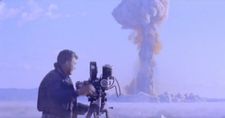 |
| Capturing a mushroom cloud in I See A Darkness |
The subject of the visible and invisible emerges in a number of ways in our film and it was addressed in a different but relevant way by Harun Farocki in Images Of The World And The Inscription Of War (a film that I think should be shown in schools!). Farocki builds his film around photographs discovered by two CIA employees in 1977 taken by American bomber aircraft in 1944 which showed Auschwitz but were never perceived as such at that time. The tragic lesson being that visual evidence has to be contextulised within a framework of perception and how that is culturally produced.
That those images of the camp had been taken unknowingly troubled Farocki for many years. Yet we now live in a time where the IDF intentionally neutralises telecommunication masts in Gaza (80% have been destroyed along with the killing of at least 122 journalists and war photographers according to the UN) to block images of the massacre of civilian Palestinians from being shared worldwide. We felt the presence of Farocki and his work intensely when making our film. I had met Farocki a few times, lastly in Berlin with my good friend Sylvère Lotringer shortly before Farocki’s sudden death and had hoped to work with him on a project in Ireland.
Our friend, the film theorist Raymond Bellour, sees a strong affinity between Farocki and Foucault and wrote that Farocki developed an ‘archaeology of photographic reason’. In terms of looking at the visible and invisible, Bellour expresses it best: “One passes, with the appearance of photography and everything it entails, from a constructed visibility to the almost uncontrollable multiplication of invisibilities that this visibility presupposes.”
Regarding your question about personal photographs as a way of remembering loved ones —I have always had a stubborn resistance to personal photographs and their (in my mind) often oppressive mode of subjectivation, and have tried to avoid being photographed myself as much as possible. There is a period of almost 10 years of my life where there are simply no photos of me. I found when my mother died 20 years ago that rather than trying to find solace in photos of her which I had, I began to collect old photographs of women who looked like her, found in flea markets in Lisbon, Berlin, Paris. Many of the photos attracted me as the women were posed in a similar way to portraits I had of her – sitting on a beach in her twenties or lying next to a bicycle in her teens, and they seemed to have an affective power that surpassed her own image —but I think it was because these images of anonymous women (most of them dead I’m sure) had an emotional impact because of their very anonymity – it made them very singular and absorbed my gaze and attention totally. They allowed me to think outside of all the layers of habit and cliché that creeps in when you become so used to familiar images, and in fact allowed me to remember and grieve for my mother in new ways.
I think the relationship between a representation of a loved one, in a drawn or painted portrait say, already involves many layers to do with memory and the visual, but when you move into the photographic and moving images it becomes even more complex, as we learn culturally how to produce and perceive these forms of mnemonic processes. Our relationship to time passing and death are central to how we try to grasp onto images. Given the glut of almost non-stop image production we experience digitally in our present culture, this probably says more about our relationship with a fear of time passing and dying than perhaps remembering a lost loved one.
JK: Much of the film seems to be interested not just in film but in the act of looking and how that defines us as a species. Do you feel that the advent of photographic technologies - and the way they've changed over time - has taught us things about ourselves that we didn't understand before?
KW: This is an important question I think and the biggest lesson that seems worth learning is that each technology creates its own regime of vision and that inventions don’t just exist as neutral tools but come embedded and weaponised by the conditions that created them, and the conditions through which they are allowed to function. In this sense very insightful and original thinkers about technology, such as Canales and Crary, but also people better known in the art world such as Trevor Paglen and the Forensic Architecture researchers in Goldsmiths College, help us to question the presumptions we have about technological ‘advancement’, especially in the visual realm. We include footage in our film from Susan Schuppli’s film Not Planet Earth and her work and book Material Witness are important in any contemporary analysis of the act of looking.
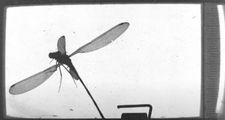 |
| A dragonfly imaged in I See A Darkness |
So, yes, our film is very much about the act of looking, and the evolution of a form of ocularcentrism in human culture, but also about the way forms of looking functioned in one particular domain we choose to focus on. Ocularcentrism defines so much of western visual culture including shaping many of the tools of colonialism (Victorian culture’s fixation with mapping is a good example of this). It is central to the issue of human dominance over animals (Anat Pick writes well about this in her book Creaturely Poetics: Animality And Vulnerability In Literature And Film),and to the problem of how women have been historically objectified (say, through the history of instruments of voyeurism).
How we look and what tools are created to facilitate and structure certain forms of looking is of great importance. By reassessing and re-interrogating aspects of contemporary culture and seeking out alternative ‘shadow’ genealogies it’s possible to come to a better understanding of just what is involved in the act of looking within human culture.
JK: How much of an educational experience was it for you, making the film?
KW: Making a film like this gives us the opportunity to meet and work with people whose thinking and writing or artistic work we admire deeply. Being able to engage in in-depth face to face conversations like that is so precious, and, for example, with an earlier film we made, The Art Of Time, was something that really changed my life, as in that instance it led to a deep friendship with Sylvère Lotringer and many collaborations with him up until his death.
With this film we spent time with the philosopher Jimena Canales (whose work I had admired for a number of years) discussing her work, and with Akira Lippitt and Jonathan Crary. What was wonderful was discovering that they were all incredibly gracious and also such brilliant thinkers on their feet, which is always lovely to discover. You’d be surprised how many people aren’t! So those encounters were ‘educational’ in that sense.
Spending time carefully researching the archives of the Conservatoire des Techniques de la Cinémathèque Françaisein Paris was illuminating as was the research we did at the MIT Edgerton archives, and the interviews we were granted at the Edgerton Centre, accompanied by spontaneous scientific demonstrations offered by the Director of that centre Kim Vandiver, were both stimulating and invaluable.
The head of the Institute of Scientific Cinematography in Paris, Alexis Martinet, was utterly fascinating and charming and so kind in showing us their archives, and opened up a whole world for us around these alternative histories of scientific representation and how many artistic traditions in that sphere have been lost. I would say that outside of the more conventional understandings of what might be deemed “educational”, it tends to be more of a deeper form of knowledge acquisition we experience with such films – they definitely change the way we see the world but also how we feel about being in the world.
JK: How important was it to capture moments of beauty and wonder in the film, to help viewers engage with it and get into the right mindset?
KW: One of the important aspects of our film was drawing attention to the fact there is (or was) a tradition in scientific cinematography that was highly aesthetic and very different perhaps to how most scientific image culture developed, although we do show in our film how for example the Hubble Telescope uses teams of artists to transform what are in effect digital codes from their information gathering devices into ‘sublime images.’
Maybe it’s more that we wanted to alert viewers to the frameworks that allow for ‘beauty’ to be experienced, as the very concept of beauty is such a contingent, culturally created one. We certainly included a lot of images we filmed that sought to capture affects that suggest and create a sense of ‘beauty’ whilst framing those affects in a context that questions them as well.
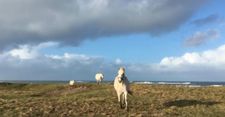 |
| White horses in I See A Darkness |
We do want viewers to experience this film on a certain aesthetic or poetic level - not like some argumentative documentary trying to prove some point but, maybe, to draw them in more ontologically, and allow certain affects and ideas to unfold more unexpectedly over the course of the film.
JK: What's next for you as a filmmaker and creative artist?
KW: What’s next very much depends on funding coming our way! We have a number of what we feel are very interesting and important projects we would like to develop, but we need the funding to do so. Our practice is a very research-intensive one, and needs the time and support to be able to move forward with projects.
Ireland doesn’t have a history of funding our kind of film essay, which is unfortunate as we see very impressive examples of such work being funded in Portugal, France, Germany and many other countries. Because there isn’t a tradition of this kind of filmmaking in Ireland, and often a lack of understanding about what you are trying to do, funding bodies tend to either prefer shorter more obvious ‘art films’ for galleries, or films that fit into a feature film format (usually having to tick predictable boxes) or TV style production values. We would argue that we know what we are doing and have extensive knowledge of artistic and cinematic genres in which we situate our work, so would like to say to funding bodies please trust us and enable us to do good work!
Outside of filmmaking I also have a curating hat I wear when I am offered the opportunity and I have a few collaborative artistic projects for galleries that I’m trying to develop which will involve a number of artists, activists, musicians and philosophers if I pull them off – again it all depends on funding. And I write as well so I will be working on some future writing.
JK: How do you feel about the film screening at Docs Ireland?
KW: We are delighted to be screening at Docs Ireland and hopefully have the opportunity to meet other filmmakers and cinephiles attending as well as producers and distributors who might be interested in our future projects.





















